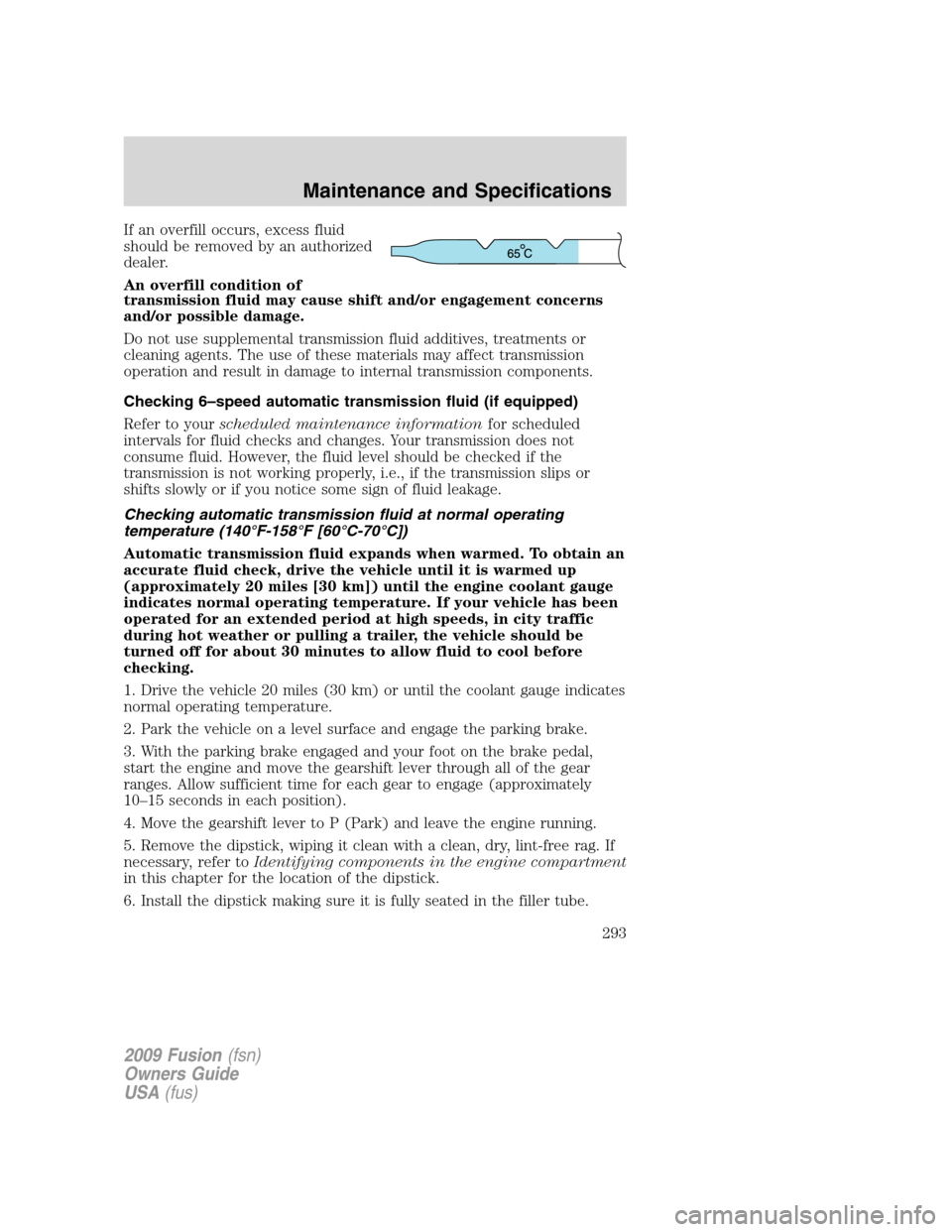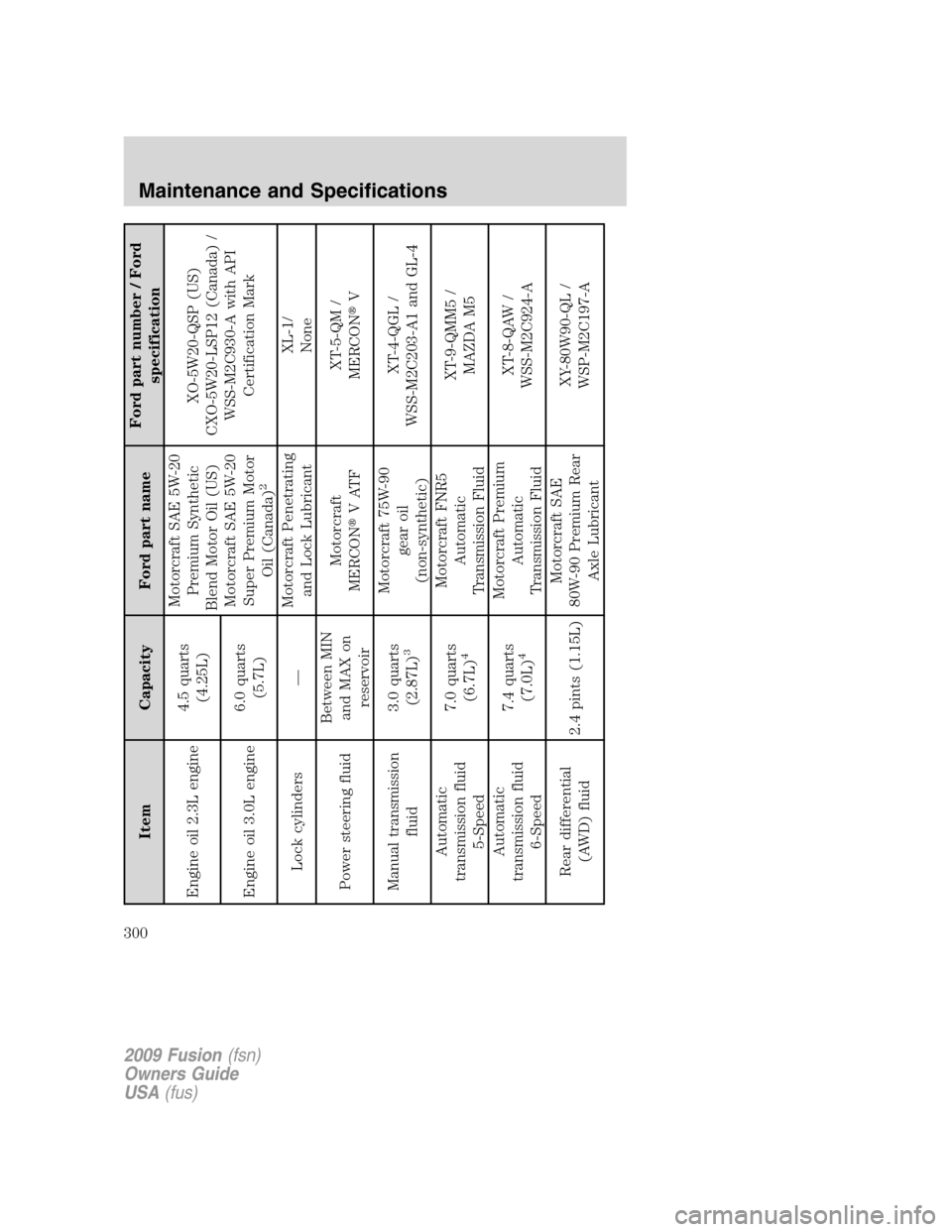Page 291 of 312

The fluid level will drop slowly as
the brakes wear, and will rise when
the brake components are replaced.
Fluid levels between the “MIN” and
“MAX” lines are within the normal
operating range; there is no need to
add fluid. If the fluid levels are
outside of the normal operating
range the performance of the
system could be compromised; seek
service from your authorized dealer
immediately.
TRANSMISSION FLUID
Checking 5–speed automatic transmission fluid (If equipped)
Refer to yourscheduled maintenance informationfor scheduled
intervals for fluid checks and changes. Your transmission does not
consume fluid. However, the fluid level should be checked if the
transmission is not working properly, i.e., if the transmission slips or
shifts slowly or if you notice some sign of fluid leakage.
Automatic transmission fluid expands when warmed. To obtain an
accurate fluid check, drive the vehicle until it is warmed up
(approximately 20 miles [30 km]). If your vehicle has been
operated for an extended period at high speeds, in city traffic
during hot weather or pulling a trailer, the vehicle should be
turned off for about 30 minutes to allow fluid to cool before
checking.
1. Drive the vehicle 20 miles (30 km) or until it reaches normal operating
temperature.
2. Park the vehicle on a level surface and engage the parking brake.
3. With the parking brake engaged and your foot on the brake pedal,
start the engine and move the gearshift lever through all of the gear
ranges. Allow sufficient time for each gear to engage.
4. Latch the gearshift lever in P (Park) and leave the engine running.
5. Remove the dipstick, wiping it clean with a clean, dry lint free rag. If
necessary, refer toIdentifying components in the engine compartment
in this chapter for the location of the dipstick.
6. Install the dipstick making sure it is fully seated in the filler tube.
7. Remove the dipstick and inspect the fluid level. The fluid should be in
the designated areas for normal operating temperature.
MAX
MIN
2009 Fusion(fsn)
Owners Guide
USA(fus)
Maintenance and Specifications
291
Page 293 of 312

If an overfill occurs, excess fluid
should be removed by an authorized
dealer.
An overfill condition of
transmission fluid may cause shift and/or engagement concerns
and/or possible damage.
Do not use supplemental transmission fluid additives, treatments or
cleaning agents. The use of these materials may affect transmission
operation and result in damage to internal transmission components.
Checking 6–speed automatic transmission fluid (if equipped)
Refer to yourscheduled maintenance informationfor scheduled
intervals for fluid checks and changes. Your transmission does not
consume fluid. However, the fluid level should be checked if the
transmission is not working properly, i.e., if the transmission slips or
shifts slowly or if you notice some sign of fluid leakage.
Checking automatic transmission fluid at normal operating
temperature (140°F-158°F [60°C-70°C])
Automatic transmission fluid expands when warmed. To obtain an
accurate fluid check, drive the vehicle until it is warmed up
(approximately 20 miles [30 km]) until the engine coolant gauge
indicates normal operating temperature. If your vehicle has been
operated for an extended period at high speeds, in city traffic
during hot weather or pulling a trailer, the vehicle should be
turned off for about 30 minutes to allow fluid to cool before
checking.
1. Drive the vehicle 20 miles (30 km) or until the coolant gauge indicates
normal operating temperature.
2. Park the vehicle on a level surface and engage the parking brake.
3. With the parking brake engaged and your foot on the brake pedal,
start the engine and move the gearshift lever through all of the gear
ranges. Allow sufficient time for each gear to engage (approximately
10–15 seconds in each position).
4. Move the gearshift lever to P (Park) and leave the engine running.
5. Remove the dipstick, wiping it clean with a clean, dry, lint-free rag. If
necessary, refer toIdentifying components in the engine compartment
in this chapter for the location of the dipstick.
6. Install the dipstick making sure it is fully seated in the filler tube.
2009 Fusion(fsn)
Owners Guide
USA(fus)
Maintenance and Specifications
293
Page 296 of 312
WARNING:To reduce the risk of vehicle damage and/or
personal burn injuries do not start your engine with the air
cleaner removed and do not remove it while the engine is running.
Changing the air filter element
•2.3L I4 engine
•3.0L DOHC V6 Duratec engine
1. Release the clamps that secure the air filter housing cover.
2. Carefully separate the two halves of the air filter housing.
•2.3L I4 engine
2009 Fusion(fsn)
Owners Guide
USA(fus)
Maintenance and Specifications
296
Page 297 of 312

•3.0L DOHC V6 Duratec engine
3. Remove the air filter element from the air filter housing.
4. Wipe the air filter housing and cover clean to remove any dirt or
debris and to ensure good sealing.
5. Install a new air filter element. Be careful not to crimp the filter
element edges between the air filter housing and cover. This could cause
filter damage and allow unfiltered air to enter the engine if not properly
seated.
6. Replace the air filter housing cover and secure the clamps.
Note:Failure to use the correct air filter element may result in severe
engine damage. The customer warranty may be void for any damage to
the engine if the correct air filter element is not used.
MOTORCRAFT PART NUMBERS
Component 2.3L I4 engine 3.0L DOHC V6 Duratec
engine
Air filter element FA-1785 FA-1786
Battery BXT-96R BXT-40R
Oil filter FL-2017-B
1FL-500-S
PCV valve2
Spark Plugs3
1
When changing oil filter you must also replace the filter cap O-ring. The
oil filter drain plug O-ring must also be replaced whenever the oil filter
drain plug is removed. Reuse of the O-rings may cause engine oil leakage
and may result in severe engine damage. The customer warranty may be
void for any damage to the engine if the O-rings are not replaced.
2The PCV valve is a critical emission component. It is one of the items
listed inscheduled maintenance informationand is essential to the
life and performance of your vehicle and to its emissions system.
2009 Fusion(fsn)
Owners Guide
USA(fus)
Maintenance and Specifications
297
Page 298 of 312
For PCV valve replacement, see your authorized dealer. Refer to
scheduled maintenance informationfor the appropriate intervals for
changing the PCV valve.
Replace the PCV valve with one that meets Ford material and
design specifications for your vehicle, such as a Motorcraft or
equivalent replacement part. The customer warranty may be void
for any damage to the emissions system if such a PCV valve is not
used.
3For spark plug replacement, see your authorized dealer. Refer to
scheduled maintenance informationfor the appropriate intervals for
changing the spark plugs.
Replace the spark plugs with ones that meet Ford material and
design specifications for your vehicle, such as Motorcraft or
equivalent replacement parts. The customer warranty may be
void for any damage to the engine if such spark plugs are not
used.
2009 Fusion(fsn)
Owners Guide
USA(fus)
Maintenance and Specifications
298
Page 299 of 312
MAINTENANCE PRODUCT SPECIFICATIONS AND CAPACITIES
Item Capacity Ford part nameFord part number / Ford
specification
Brake (and clutch–if
equipped) fluidBetween MIN
and MAX on
reservoirMotorcraft High
Performance DOT 3
Motor Vehicle Brake
FluidPM-1-C /
WSS-M6C62-A or
WSS-M6C65-A1
Door weatherstrips —Silicone Spray
LubricantXL-6 /
ESR-M13P4-A
Door latch, hood
latch, auxiliary hood
latch, door hinges,
striker plates, seat
tracks and fuel filler
door hinge— Multi-Purpose GreaseXG-4 or XL-5 /
ESB-M1C93-B
Lock cylinders —Motorcraft Penetrating
and Lock LubricantXL-1 /
None
Engine coolant 2.3L
engine8.56 quarts
(8.1L)Motorcraft Premium
Gold Engine Coolant
with bittering agent
(yellow-colored)
1
VC-7-B /
WSS-M97B51-A1
Engine coolant 3.0L
engine9.72 quarts
(9.2L)
Cooling system stop
leak pellets—Motorcraft Cooling
System Stop Leak
PelletsVC-6 /
WSS-M99B37-B6
2009 Fusion(fsn)
Owners Guide
USA(fus)
Maintenance and Specifications
299
Page 300 of 312

Item Capacity Ford part nameFord part number / Ford
specification
Engine oil 2.3L engine4.5 quarts
(4.25L)Motorcraft SAE 5W-20
Premium Synthetic
Blend Motor Oil (US)
Motorcraft SAE 5W-20
Super Premium Motor
Oil (Canada)
2
XO-5W20-QSP (US)
CXO-5W20-LSP12 (Canada) /
WSS-M2C930-A with API
Certification Mark
Engine oil 3.0L engine6.0 quarts
(5.7L)
Lock cylinders —Motorcraft Penetrating
and Lock LubricantXL-1/
None
Power steering fluidBetween MIN
and MAX on
reservoirMotorcraft
MERCON�VATFXT-5-QM /
MERCON�V
Manual transmission
fluid3.0 quarts
(2.87L)
3
Motorcraft 75W-90
gear oil
(non-synthetic)XT-4-QGL /
WSS-M2C203-A1 and GL-4
Automatic
transmission fluid
5-Speed7.0 quarts
(6.7L)
4
Motorcraft FNR5
Automatic
Transmission FluidXT-9-QMM5 /
MAZDA M5
Automatic
transmission fluid
6-Speed7.4 quarts
(7.0L)
4
Motorcraft Premium
Automatic
Transmission FluidXT-8-QAW /
WSS-M2C924-A
Rear differential
(AWD) fluid2.4 pints (1.15L)Motorcraft SAE
80W-90 Premium Rear
Axle LubricantXY-80W90-QL /
WSP-M2C197-A
2009 Fusion(fsn)
Owners Guide
USA(fus)
Maintenance and Specifications
300
Page 301 of 312

Item Capacity Ford part nameFord part number / Ford
specification
Power transfer unit
(PTU) fluid (AWD)
5
12 ounces
(0.35L)Motorcraft SAE
75W-140 Synthetic
Rear Axle LubricantXY-75W140-QL /
WSL-M2C192-A
Windshield washer
fluid4.75 quarts
(4.5L)Motorcraft Premium
Windshield Washer
ConcentrateZC-32-A /
WSB-M8B16-A2
Fuel tank (FWD)17.5 gallons
(66.2L)——
Fuel tank (AWD)16.5 gallons
(62.4L)——
1Add the coolant type originally equipped in your vehicle.2Use of synthetic or synthetic blend motor oil is not mandatory. Engine oil need only meet the
requirements of Ford specification WSS-M2C930-A and the API Certification mark.3Service refill capacity is determined by filling the transmission within 3/8 inch (10mm) of the
bottom of the filler hole with the vehicle on a level surface.4Indicates only approximate dry-fill capacity. Some applications may vary based on cooler size and
if equipped with an in-tank cooler. The amount of transmission fluid and fluid level should be set
by the indication on the dipstick’s normal operating range.5The Power Transfer Unit is lubricated for life with synthetic lube. Lubricant levels are not to be
checked or changed unless a leak is suspected or repair required. Replace Power Transfer Unit
lubricant with specified synthetic lubricant anytime the unit is submerged in water.
See your authorized dealer for fluid level checking or filling of the Power Transfer Unit.
2009 Fusion(fsn)
Owners Guide
USA(fus)
Maintenance and Specifications
301